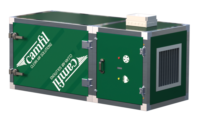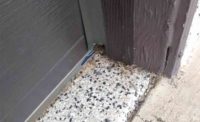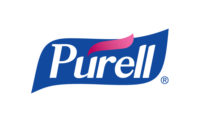Now more than ever, in the midst of a global pandemic, it is imperative for companies to have stringent maintenance and sanitation protocols, prioritizing employee safety. Luckily, many companies are upping their game, and even installing new maintenance and employee relief areas.
Usage of air handling equipment, always an important part of snack and bakery facilities, has exploded in popularity during the COVID-19 pandemic.
“As a society, we do not tolerate dirty water because we can see it, we can taste it, but that’s not always true with dirty air. Our eyes can’t see a microscopic, virus-laden aerosol particle floating right in front of us. So we protect ourselves with face masks, which are essentially air filters for our face,” says Mark Davidson, marketing and technical materials manager, Camfil USA Inc., Des Peres, MO.
“We’ve learned it’s what we can’t see that matters,” says Davidson. “There’s an expectation now in retail environments, offices, and all work spaces that steps are being taken behind the scenes to make the air safer to breathe. That has driven those with the responsibility for their facility’s HVAC to contact Camfil for solutions to their unique applications.”
Rick Kreczmer, president, RoboVent, Sterling Heights, MI, says that ventilation and air filtration have very much been in the news over the last 18 months due to the COVID pandemic. “Many businesses are interested in upgrading ventilation systems and improving filtration to meet CDC and ASHRAE recommendations for reducing pathogen spread. Our sister companies in the Rensa Filtration family have seen tremendous growth in replacement HVAC filter sales, particularly for HEPA and MERV 13 and higher. RoboVent's typical solutions will provide filters with a MERV 15 rating. At RoboVent, we are working with customers to help them develop integrated air filtration and ventilation solutions that create healthier, safer indoor environments.”
Scott Houtz, president, Air Management Technologies, Lewisburg, PA, says that since the pandemic started, the company has fielded many questions pertaining to what measures to implement to improve air quality with existing systems, but haven’t seen substantial increases in air management investments by food processors. “It is our opinion this may be because food processing facilities are already ahead of the curve. Many of the design concepts recommended by the CDC have become commonplace in the food industry due to FSMA and other requirements such as increased air filtration efficiencies, outdoor ventilation air, air cleaning technologies, and similar product safety enhancements,” he notes.
“At the same time, the pandemic has definitely impacted the markets we serve,” says Houtz. “Some of our traditional industrial manufacturing markets, including automotive, have had to ramp down production due to ongoing chip shortages. On the other hand, we’re seeing other industries ramp up, like nutraceuticals, exercise equipment, and food and beverage, in response to changing consumer behaviors. We are actively reaching out to these industries to help them expand production safely in regards to indoor air quality. We’re very excited by the opportunities in the food processing and packaging sector.”
Tom Leach, national sales manager, pneumatic conveying, CAMCORP, Lenexa, KS, agrees, saying that some manufacturers are adjusting production output capacity and this adjustment can have an impact on maintenance and schedules. “As we have seen in the baking and snack industry among many others, Coronavirus has negatively impacted the supply chains, fluctuating steel prices, and has caused delivery delays. Many customers have felt the disruption to their up-stream supply chains experiencing reduced output. The production capabilities are limited because some workers have been required to stay at home to limit the spread of COVID-19.”
Dynamic Air Quality Solutions, Princeton, NJ, manufactures high-efficiency air cleaning and high-output germicidal UVC systems. “To put it mildly, we were really busy,” says Duke Wiser, president & CEO.
“Our systems require about one-third of the fan energy and have a far longer maintenance cycle than traditional alternatives and our business had been up significantly for the last several years,” says Wiser. “2020 continued that trend and was our busiest ever. Like other manufacturers, we had to do this while dealing with the challenges of increasing production while implementing social distancing and dealing with disrupted supply chains. But it was great to be able to produce things that could help in the fight,” he comments.
Company: Air Management Technologies
Website: https://airmanagement.com
SANITATION Snapshot: One of the company’s new innovations developed recently for food processors is a remote monitoring and verification system which can serve a single location or be used to provide a global hub and provide real time reporting of key Environmental Performance Indicators (EPI) that relate to Food and Occupant Safety.
“This provides verification rather than assumes investments in system replacement, retrofits, and operations related to air quality are achieved and that performance is maintained for the lifecycle. This information can be sourced by the client or externally pushed to Corporate Safety Teams. Some parameters the Air Management Technologies ‘EPI-Vision’ family of systems gathers include various temperatures, humidity, airborne particulates, space pressurization, and wind speed, among others as required. Outdoors climatic data is compared with indoors to discern conditions in different geographic areas,” says Houtz.
“Why this is so important is that it allows notification of potential risk factors based on industry standards which are many times unknown and demonstrates a standard of care related to occupant health factors as well as food safety. When this information is integrated with facility air management systems it can provide significant savings through dynamic operation and provide demonstrated accountability of a solution and or ongoing maintenance activities. In addition, processes that have environmental control parameters can also be integrated and monitored by this same system,” Houtz says.
Company: Camfil
Website: www.camfil.com
SANITATION Snapshot: Before the pandemic, if you searched “air purifiers” on Amazon, you would have seen only a few options. Do that today and you wouldn’t be able to count them all, says Davidson. “An air purifier can supplement existing HVAC systems with HEPA filters and provide an extra layer of protection. Unfortunately, the high demand has opened doors for new purifiers that don’t always use actual HEPA filters. Be careful buying something that puts too much emphasis on chemicals or ionizers to kill viruses and not enough on the filter. Air purifiers are a great addition to homes, schools and retail stores, but stick with what works; stick with HEPA filters. Camfil’s room air purifier, the City M, uses two HEPA filters tested and certified to remove 99.995 percent of the smallest particles.”
In the early days of the pandemic, it became obvious that hospitals needed more rooms to treat infectious patients, says Davidson. “Camfil developed a 500 CFM unit, the CC500, that could exhaust HEPA-filtered air to create negatively pressurized isolation areas out of regular patient rooms or other spaces. The unit was portable so it could be wheeled into position or mounted on a wall or ceiling. The really great thing about this unit is it easily converts to a room recirculation air purifier to deliver HEPA-filtered air. And it’s not just a unit for hospitals—schools and industry has found its capabilities very useful also.”
Company: Dynamic Air Quality Solutions
Website: www.dynamicaqs.com/air-cleaners
SANITATION Snapshot: In light of ASHRAE’s recommendations for germicidal UVC and the rising demand, Dynamic Air Quality Solution expanded its offering of high-output UVC lamps with a line of systems that install easily and quickly into existing ductwork and A/C units.
“We have not seen the pace slowing down. I think that the pandemic has raised the bar for the expectations of air quality in buildings. Further, more and more people have recognized that the cost of air filtration is not in the filters, but rather in the energy to push air through them. 90 percent of the cost of air filtration is energy. So, facilities that upgraded their passive filters to higher MERV efficiencies—if they were able to—have likely seen an increase in energy costs as well as the number of filter change-outs required. Our products solve those problems,” says Wiser.
Company: RoboVent
Website: www.robovent.com
SANITATION Snapshot: In 2021, RoboVent released Senturion, its most powerful and flexible dust collector to date. Senturion is a filtration and collection solution for companies engaged in industrial food processing and packaging. It has an advanced filtration system that gives it the smallest footprint per CFM in the industry, and it can be easily sized up and down for different applications and facilities. It’s also built to handle the highly combustible dust produced by grains, starches and flours.
While it’s not new this year, the pandemic has also created new interest in the company’s PRC series, a portable air filtration unit that can be equipped with a MERV 15 or HEPA filter, says Kreczmer. “It’s a great solution to increase the air turnover rate and capture pathogens in environments where upgrading the whole HVAC system is impractical or cost-prohibitive,” he notes.








